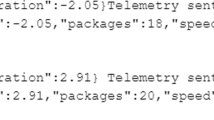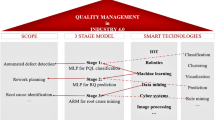Abstract
In today’s globally competitive industries, high-quality and high-reliability products play an important role in achieving customer satisfaction, and insisting on quality is always the only way to survive in an enterprise. Studies indicate that automating quality audits and adding decision support in quality improvement is an attractive idea. In this environment, production workflow mining is an approach for extracting knowledge from different manufacturing processes in order to assist real-time quality prediction and improvement. This papers attempts to propose an intelligent production workflow mining system (IPWMS) embracing online analytical processing (OLAP) and data mining technology, together with the use of artificial intelligence combining artificial neural networks (ANNs) and fuzzy rule sets to realize knowledge discovery and decision support in high-quality manufacturing. To validate the feasibility of the proposed system, a prototype is developed and evaluated in a company, and a description of this case example is covered in this paper.
Similar content being viewed by others
References
Davenport T (1997) Secrets of successful knowledge management. http://webcom.com/quantera/secrets.html
Waltz E (2003) Knowledge management in the intelligence enterprise. Artech, Norwood
Van der Aalst WMP, Van Dongen BF, Herbst J, Maruster L, Schimm G, Weijters AJMM (2003) Workflow mining: a survey of issues and approaches. Data Knowl Eng 47:237–267
Liu TI, Yang XM (1999) Design for quality and reliability using expert system and computer spreadsheet. J Franklin Inst 336:1063–1074
Van Dijk JC, Williams PA (1990) Expert system in auditing. Macmillan, London
Besterfield DH (2004) Quality control, 7th edn. Prentice-Hall, New York
Lawrence S (1998) Fundamentals of industrial quality control, 3rd edn. St. Lucie Press, Boca Raton
Ament C, Goch G (1999) A learning fuzzy control approach to improve manufacturing quality. IEEE, September, pp 156–161
Kim I-S, Son J-S, Yarlagadda PKDV (2003) A study on the quality improvement of robotic GMA welding process. Robot Comput Integr Manuf 19:567–572
Postlethwaite I, Atack PA, Robinson IS (1996) The improved control for an aluminum hot reversing mill using the combination of adaptive process models and an expert system. J Mater Process Technol 60:393–398
Paladini EP (2000) An expert approach to quality control. J Exp Syst Appl 18:133–151
Dahr V, Stein R (1997) Seven methods for transforming corporate data into business intelligence. Prentice-Hall, New York
Haykin S (1999) Neural Networks: A Comprehensive Foundation. Second Edition. Prentice-Hall
Liu JNK (1997) Quality prediction for concrete manufacturing. J Automat Constr 5(6):491–499, March 1997
Von Altrock C (1997) Fuzzy logic and neurofuzzy application in business and finance. Prentice-Hall, New York
Buchanan BG, Shortliffe EH (1984) Rule-based expert systems. Addison-Wesley, Boston
Leung KS, Lam W (1988) Fuzzy concepts in expert systems. IEEE, September, pp 43–56
Orchard A (1994) FuzzyCLIPS Version 6.02 A User’s guide, National Research Council,
Lou HH, Huang YL (2003) Hierarchical decision making for proactive quality control: system development for defect reduction in automotive coating operations. Eng Appl Artif Intell 16:237–250
Negnevitsky M (2002) Artificial Intelligence: A guide to intelligent systems. First Edition, Addison Wesley
Qnet (2000) Qnet for Windows, User’s Guide. Winnetka, USA
MathWorks (2002) Fuzzy Logic Toolbox user’s guide. MathWorks, Natick, MA
Author information
Authors and Affiliations
Corresponding author
Rights and permissions
About this article
Cite this article
Ho, G., Lau, H., Lee, C. et al. An intelligent production workflow mining system for continual quality enhancement. Int J Adv Manuf Technol 28, 792–809 (2006). https://doi.org/10.1007/s00170-004-2416-9
Received:
Accepted:
Published:
Issue Date:
DOI: https://doi.org/10.1007/s00170-004-2416-9




